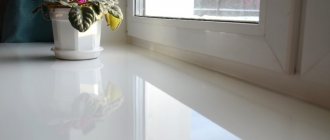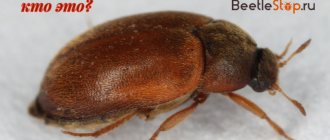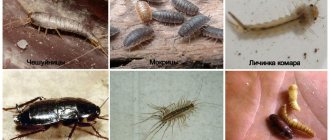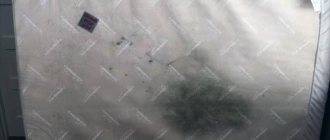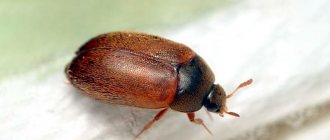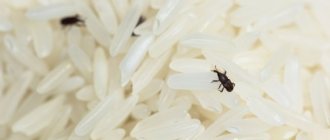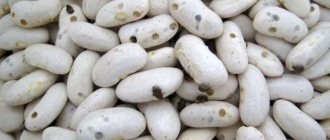How to deal with white insects in an apartment
To combat insects in a residential apartment, it is better to use drugs that are safe for humans, although in some cases (especially when the area is massively populated by parasites) chemically active agents will still be needed.
- The fight against silverfish should be comprehensive - first, clean the area from dust, dirt and cobwebs, and then treat it with chlorine-containing household chemicals. After waiting for the surfaces to dry, wipe all corners and hidden places with a solution of copper sulfate; it is advisable to dry the area using a fan heater (for small areas, a regular hairdryer is suitable). After a couple of hours, final cleaning with vinegar water is required - ½ cup of regular vinegar per bucket of warm water.
- Sugar silverfish most often grow in bookcases and shelves with papers, so these areas should be given special attention to eliminate the pest. Books and magazines should be rearranged and emptied, as eggs may be laid in them, and bookshelves can be sprayed with lemon water or thoroughly vacuumed.
- To eliminate food white midges, you will have to throw away all bulk food: even if you do not see bugs there at the moment, this does not mean that the cereal is clean. There are already numerous parasite eggs in it, and in a few days the insects will appear again. After cleaning all the cans and boxes, you should carry out a comprehensive treatment of the kitchen drawers using a soda solution or store-bought insecticides. After a couple of hours, the furniture should be washed with soapy water and additionally sprayed
Modern aerosol preparations are suitable for combating any type of insect, so they can be used as a protective or prophylactic agent against any type of parasite.
Fighting methods
Depending on how heavily infested the products are with bugs, methods of combating them are selected.
Thorough cleaning of the premises is reliable prevention.
- We found two or three bugs in the rump, don’t be upset. Pour the cereal onto a baking sheet and heat in the oven at 100 degrees. The container will have to be destroyed and a new one prepared. Before cooking, rinse the cereal in additional salt water.
- If you're unlucky enough to spot a colony of little parasites in one of your cereal bags, you'll have to throw out the entire product, even if it's barely used. The ubiquitous bugs quickly settle in and inevitably look into open containers and find microscopic cracks in sealed packages. Therefore, you need to conduct a thorough audit of all supplies stored in cabinets.
- It is better to heat-treat visually undamaged products by placing them in the freezer of the refrigerator for two days. The bugs themselves easily tolerate -15 and 50 degrees, but the eggs they lay, which are difficult to notice with the naked eye, will certainly die from such exposure.
- To prevent re-infestation, you should wash the cabinets with disinfectant cleaners. For a better effect, you can wipe the shelves with a solution of 9% vinegar.
- Replace bags and sacks for all products that may become the target of bugs.
- Soak tin and plastic cans for half an hour in a saturated soap solution, then rinse them thoroughly with warm water and dry.
- All cracks in the floor, walls and window sill must also be treated. Check door hinges, drawer latches and shelf holders. Pour boiling water over them and wipe dry.
We suggest you read: What can get into the sofa and bite, where do insects come from?
White insects in the apartment - who are they?
While recognizing cockroaches and ants is not difficult, the appearance of strange little bugs causes serious difficulties, since in order to eliminate parasites, one must know their exact type.
Let's try to figure out who can start up in the house.
- The most common type of parasitic white insects in an apartment is silverfish (in common parlance - woodlice). It is a small wingless individual, an oblong body with numerous legs. In fact, the body of the parasite is not completely white, it is rather silver, but in sunlight it appears almost transparent. Such insects feed on starch and products containing it. Due to the fact that silverfish choose damp places, the main area where the insects will be located will be the bathroom or kitchen, especially the sink area.
- The sugar silverfish can be designated as a separate species; it most often appears in food warehouses, kitchen drawers with food, and libraries (since it loves book bindings and glued pages). Such insects come out only in the dark, so it is quite difficult to detect them.
- White midges most often appear on indoor plants; this insect is called a whitefly. It is almost impossible to prevent its occurrence, but it is very easy to escape from it - just treat the soil and affected leaves with a weak solution of manganese, repeating the procedure if necessary.
- Light-colored bugs in kitchen cabinets can be food midges; they feed on cereals and other bulk products, spread very quickly, and in a few days the pest population can increase several times. These insects can appear in an apartment due to improper sanitary conditions - high levels of humidity, the presence of crumbs and other debris. Having appeared in one product, after a couple of hours the midges will move to other places, and they actively infect even hermetically sealed products.
Of course, there are other representatives of parasitic insects that can occur in an apartment; each species has its own means of control, but if you cannot determine the exact type of pest, use complex preparations that help get rid of any apartment parasites.
What to do if silver insects are crawling in the bathroom
A more effective method of exterminating pests is the use of special insecticides. If silvery insects are crawling in the bathroom, you can use the following products to bait them:
- Aerosol Delicia
- Scabengel
- Ram
- Tarax
- Avalon
- Argus Traps
- Delta Zone
- Aerosol Combat Multispray
- Xulat
- Contra Insect
- Master 250 MKS
- Empire 20
- Tsipromal
- Gett
- Varan
- Tetrix
- Lambda Zone
If you don’t want to remove insects yourself or you can’t do it, you can turn to the SES for help. This is the fastest and easiest way to solve the problem.
- Professional bathroom cleaning is done in just 1 day.
- The procedure for one bathroom takes a maximum of 1.5 hours.
- Only modern high-quality products are used in our work.
- The smell of drugs is quickly removed by ventilation, so the bath can be used just a few hours after treatment.
- You receive an official guarantee for the result.
- Treatment can be ordered urgently; specialists will be at your home within 2 hours after your request.
SES Dez Group, certified by Rospotrebnadzor, has been helping individuals, companies and government organizations get rid of all types of insects at all types of facilities for more than 13 years. By contacting the service, you can be sure of the absolute result and complete safety of the procedure for people and pets.
Mole
These insects can spoil not only things in cabinets, but also food. Moth larvae and caterpillars are found in bulk products (flour, cereals); they may also take a liking to dried fruits. Moths multiply very quickly in an apartment, so you need to start fighting them immediately after detection. What methods of combating these insects are:
- Using repellents against butterflies. This could be a chemical compound - naphthalene, or it could be herbal remedies - geranium and lavender.
- A much more pronounced result is obtained by chemical treatment, for which dichlorvos is used.
No matter what insects that are resistant to poisons and influences pester you, you can still cope with them. But if you are already desperate to do it yourself, contact a pest control specialist. These guys know their stuff and can help even in the most advanced cases.
Woodlice
These insects have an oval body of light gray, white, beige or brown, convex on top, and consists of several segments. The bug has 7 pairs of legs and a hard shell, and in front there are antennae up to half the length of the body. In nature, woodlice love damp places, which is where they got their name, but sometimes they settle near human habitation. They can climb into the cellar and into some rooms in the house (bathroom or toilet) where there is high humidity.
You can see such insects in the toilet or bathroom only when you turn on the light at night, because during the day they hide in secluded corners. Woodlice feed on plant debris and can harm plants in the garden. Inside residential premises, they can live not only in the bathroom and toilet, but also in living rooms where there are decorative flowers in pots. Here they find not only water, but also food.
Penetrating into living spaces, woodlice can not only frighten people who are disgusted by insects that run quickly, but due to moisture and mold they become carriers of various fungal diseases, which pose a danger to human health.
Therefore, it is imperative to combat such moisture-loving insects, taking all possible measures to destroy them.
Preventing the appearance of small midges and bugs in the apartment
It is much easier to prevent the appearance of small parasites in a residential building than to eliminate colonies that have appeared on a massive scale.
- Firstly, avoid the accumulation of dust and dirt in the room, since small bugs most often appear in dusty places. To protect furniture from pests when wiping dust, you can use a polish; this product has a double effect - it removes dirt and repels insects with a specific smell,
- secondly, monitor the condition of pipes and risers in the apartment, eliminate condensation on windows and glass-ceramic surfaces, it is moisture that attracts woodlice and other types of silverfish,
- thirdly, periodically thoroughly ventilate the room, this way you will saturate your living area with oxygen and help eliminate all insect egg clutches laid by this time, since pests cannot tolerate cold,
- fourthly, to protect your apartment from the invasion of small pests, it is worth using such harmless products as soda, laundry soap, lemon when cleaning the premises - these components do not have a negative effect on humans, but they do an excellent job against insects,
- fifthly, the use of herbs is considered an excellent means of preventing the appearance of insects in kitchen and wardrobes, as well as among books. Rosemary, lavender, walnut, eucalyptus have a pleasant smell for humans, but many insects cannot tolerate this aroma. You can use dry bunches of herbal mixtures, laying them out on shelves and under tables; for the same purpose, it is permissible to lay out unpeeled garlic cloves in kitchen drawers.
By taking precautions, you will not encounter the problem of removing insects from your apartment, so you should not neglect them, especially since all the proposed remedies are very simple and accessible to everyone without exception. .
Prevention of bugs
In order not to solve the problem when white insects appear in the apartment, the following preventive measures should be taken:
- regularly wipe off condensation and dust on pipes;
- Maintain cleanliness in the bathroom and toilet;
- check how well the ventilation works in service areas (toilet, bathroom, kitchen), if necessary, periodically clean the shafts;
- make cosmetic repairs by sealing all existing cracks near the baseboards, in the walls and on the floor;
- If there is a leak, the taps should be repaired immediately, avoiding the accumulation of moisture;
- dry corners that are too wet using a fan heater, because insects can lay eggs in such places, and hot air will destroy them;
- if mold appears, such areas should be thoroughly treated with chlorine and then dried;
- in the kitchen you should regularly check all cereal stocks and do not leave crumbs;
- prevent the accumulation of garbage, remove food and other waste in a timely manner.
With regular cleaning, drying and compliance with hygienic rules in service areas (bathroom, toilet and kitchen), no white insects will be able to settle in the house due to the lack of the high humidity necessary for them.
At any time of the year, uninvited guests in the form of annoying insects can appear in your home. They appear due to dampness, lack of sanitary conditions, and can also enter the room through open windows and doors or through holes in walls or risers.
Why do insects appear in the apartment?
The reason for the appearance of insects in the house can be a variety of factors, the main ones are:
- uninhabited atmosphere in the apartment - i.e. constant high humidity or, on the contrary, excessively dry air, lack of oxygen and regular water evaporation,
- violation of hygiene standards in the house - lack of order and dirt in the room become the basis for the creation of mold and fungal deposits on the walls and floor, as a result of which woodlice and wood lice appear. Such parasites are not only annoying with their appearance, but can also bite painfully,
- the proximity of a residential building to bodies of water, a forest, or an apartment on the first floors (directly above the basement) - all this will be beneficial for insects, since they will be able to penetrate your home without much difficulty,
- poisoning of parasites in neighboring apartments - extermination of pests should be carried out comprehensively, since the use of gentle chemicals does not destroy insects, but simply makes their living in the treated area uncomfortable, so the parasites move to neighboring apartments and houses.
Insect habitats
Absolutely all insects cannot do without water, therefore, when they get into an apartment, they look for rooms and places in them located closer to sources of moisture:
- pipes (water supply and sewerage) on which condensate accumulates;
- hard-to-reach and well-hidden areas in the bathroom, near communications;
- wet or damp rugs on the floor, various hygiene products with moisture residues;
- places where dust accumulates and is not removed (the floor under the bathroom, the backs of shelves in a cabinet, etc.).
The appearance of white or gray bugs in the bathroom is most often caused by poor sanitary conditions in the room. In addition, some insects may come from neighbors after baiting has been carried out in their apartment. Some exceptionally tenacious specimens then migrate in search of a new home.
Color
If we talk about color, then compared to other insects, wasps (the species whose photos you saw above) are distinguished by a wide variety. Thus, some species are distinguished by quite bright contrasting yellow or black stripes, and have such an appearance that it is almost impossible to recognize them. They are often called wasp bees. The rest of the species may differ in completely different colors, ranging from rich black to purple or turquoise. In any case, they have a fairly recognizable body color, as a result of which they almost never become victims of random attacks, simply scaring away all kinds of birds or mammals.
It is worth noting that wasps have the maximum possible number of insect imitators, trying to copy their appearance and coloring in order to protect themselves from predators. The most famous example is the hoverfly, which is very similar to a wasp. Various mammals and birds, who know that an insect with a yellow-black color mainly has a dangerous sting, prefer not to attack, while in fact such a fly is completely harmless.
It is noteworthy that the body of wasps for the most part does not have as many hairs as is the case with bumblebees or bees, because the latter groups are standard pollinators, as a result of which they need hairs to collect nectar more efficiently. Some species of wasps do not have wings at all. Such wasps, the types and characteristics of which differ from other species, parasitize in the nests of ordinary paper wasps, while the absence of wings does not deprive them of a fairly strong poison and a powerful sting.
Bed bugs
home parasites
Bedbugs can live in almost any nook and cranny of the house, and they multiply at an extraordinary speed. Being parasites, at night insects jump onto the bed, bite people and begin to suck their blood. Surprisingly, the larvae begin to feed from the very beginning of their lives and differ from adults only in size.
By and large, several varieties of bed bugs can parasitize an apartment, but it is almost impossible to distinguish them from each other without a microscope and some knowledge.
It is much more difficult to poison these pests than cockroaches, since the majority of insecticidal preparations on sale are not effective against them. As a rule, special dusts, sprays, and aerosol insecticides are used to kill bedbugs.
House ants
thief ants and red ants
Speaking about the harm caused, it can be noted that these domestic insects - like many of their main brethren - can spread various infections and also spoil food.
The main problem with breeding ants is that very often their colonies have many nests, which are combined with each other and are even located in different apartments. It is for this reason that destroying one nest will not give the desired effect: as long as there is a single colony, the parasites will return to the apartment again and again.
It is necessary to fight them together - preferably by all residents of the house at the same time. Only in this case there will be a positive effect, otherwise, only temporary removal of ants can be achieved. Almost any insecticide is suitable for extermination, but the best method is still special poisoned bait.
Invasion of small insects in new buildings
In recent years, cockroaches in residential buildings have been replaced by small insects - hay beetles. Oddly enough, this problem is especially relevant for new buildings. Hay eaters are tiny insects whose natural habitat is in the wild. They settle under the bark of trees, in the forest floor, and on dead wood. But now they can be found in residential areas. Hay beetles especially often attack new buildings.
There are several reasons for this. Firstly, there are no natural enemies of these insects in new buildings, and they can be easily brought in from the natural environment.
Secondly, hay eaters love stagnant moisture. In modern construction, there are mistakes that lead to the accumulation of moisture in the seams between panels and floors. Small insects are attracted to under-dried casein glue, wet plaster, and grout. Stagnant moisture is an excellent environment for the development of small insects. In search of food, insects penetrate the smallest cracks, and then multiply and spread throughout the apartment. In new buildings, hay eaters most often feed on mold.
Eating methods
The class Insects is also distinguished by a variety of feeding methods. Among them you can find parasites, predators, blood-sucking, saprotrophs and herbivores. This also determines the diversity of the structure of their mouthparts. Let's remember what insects pollinate plants. These are bees and bumblebees. Their gnawing-licking oral apparatus is represented by an elongated tongue. And butterflies receive nectar with the help of a proboscis, which forms a sucking-type mouthparts.
eats plant leaves. Its gnawing apparatus is capable of grinding food. And some insects can pierce the integument of animals and plants to obtain blood or juices. These are aphids, bedbugs, mosquitoes, lice, fleas. Their mouthparts are piercing-sucking.
Insect control products for living quarters
Insect control in an apartment can be carried out with store-bought preparations, but for homes with small children or pets, the use of chemically active components is extremely undesirable, so it is permissible to use folk recipes as an alternative.
- Collections of natural herbs can rid you of nasty parasites for a long time, and the aroma of field herbs will create a pleasant atmosphere in the room. Natural ingredients can be used in different ways:
- dry bunches of lavender, geranium, mint, rosemary, laurel can be conveniently laid out in closets, on window sills, under sofas and used to create all kinds of compositions for interior decoration,
- oil extracts of plants (eucalyptus, lavender, rosemary) can be used as an additive for cleaning floors and walls,
- It is convenient to spray soft sofas, armchairs and other furniture with a herbal decoction to remove small insects - ticks, bedbugs and fleas.
- A dry mixture of salt and soda (in equal proportions) is sprinkled on the carpets overnight, after which all paths and rugs must be thoroughly vacuumed in the morning. This procedure will rid your home of fleas and ticks; it is a good idea to periodically carry out such treatment if there are pets living in the apartment - the main carriers of parasites.
- When there are bedbugs in the house, you can get rid of them using a lemon solution. One whole lemon is required per liter of clean water; you can simply squeeze the juice from the citrus and dilute it in water, or you can boil the finely chopped and crushed fruit in boiling water for about 5 minutes, then strain. The resulting solution should be sprayed on all interior items of the apartment, especially beds, sofas, pillows and other textiles. Unlike other insect repellents, lemon has a pleasant aroma and is absolutely safe for human health.
However, traditional methods do not always bring the expected result, and they are ineffective when pests have been in the apartment for a long time and have successfully taken root throughout the entire territory. In this case, modern chemistry should be used:
- aerosol preparations can be used against any type of pests; they are effective when cockroaches or ticks appear in the apartment, and they will help get rid of mosquitoes and flies. The most popular products are “Raid”, “Raptor”, ordinary dichlorvos,
- gel putties are suitable for treating cracks in floors and walls; they are applied to the curves of cabinets and between window openings. This is a convenient tool to get rid of ants, cockroaches and any crawling pests, you can use the “Clean House” gel,
- Bulk mixtures can be used dry or diluted. The toxic solution is convenient for treating tiles and smooth surfaces; it will help remove wood lice and other damp lovers. Powdered preparations effectively eliminate food flies and cockroaches,
- It is recommended to use scent traps when there are flying pests in the apartment - flies, midges, mosquitoes. Ultrasonic repellers will also help in this case; when purchasing a product, the main thing is to pay attention to the range of action of the device. If you need it exclusively for home use, you can buy the simplest and most inexpensive device, and for removing mosquitoes and mosquitoes from your summer cottage, a powerful device with a wide range of action will be useful.
Don’t wait until insects invade your home; modern protection products can reliably prevent the appearance of any parasites on your property. The money spent on purchasing store-bought drugs will definitely pay off in your peace of mind and cleanliness in your apartment.
//www.youtube.com/embed/6FEgq7RHHYU
Chemical and folk remedies
To destroy white insects in the house, insecticidal aerosols are recommended, which should be used every week (Raid, Raptor, Dichlorvos, Clean House, etc.). When carrying out processing, personal protective equipment should be used (respirator or gauze bandage, rubber gloves on hands).
Insect control products
Folk remedies against silverfish and woodlice:
- scatter diatomaceous earth in the cabinets - a substance that kills crawling parasites; its solution can be used to treat cracks in the walls, tile joints, baseboards;
- scatter spices (cloves, etc.), essential oils or citrus zest inside the cabinet, which must be changed every 4 days;
- sprinkle boric acid powder mixed with chalk (in a ratio of 1:4) on the pipes, under the toilet and sink; the solution can be used to treat the surfaces of the pipes;
- against wood lice, it is also recommended to use a solution consisting of soda ash (3 g), tobacco powder and ground red pepper per 1 liter of water - this mixture must be sprayed in places where pests accumulate (plinths, ceilings, cracks and corners in the bathroom, toilet and cellar) ;
- To catch woodlice in flower pots, baits made from potatoes or carrots are used; to do this, cut out the middle of them and leave them overnight - when they get in there, the baits are destroyed along with the bugs.
Main types of insect wings photo and structure
The wing of an insect is formed by a modified fold of skin - the thinnest two-layer wing membrane, in which chitinized veins and modified tracheal vessels pass.
As you can see in the photo, there are three sides to an insect wing - the leading edge, the outer (outer) edge and the trailing (inner) edge:
Also, the structure of an insect wing includes three angles: the base, the apex and the posterior angle. According to the direction in the wing, the veins are divided into longitudinal and transverse. The basis of venation is made up of large, often branched longitudinal veins that reach the edges of the wing. Small, non-branching transverse veins are located between adjacent longitudinal ones. The veins divide the wing membrane into a number of cells, which are closed, completely limited by the veins, and open, reaching the edge of the wing.
The structure of the wings is considered in two main aspects: venation (the number and arrangement of veins) and consistency (the thickness and density of the wing plate). There are two main types of venation in insect wings. Reticulated is a dense, fine-mesh venation in which, in addition to longitudinal veins, there are many small transverse veins, forming numerous (more than 20) closed cells. Such venation is developed in dragonflies, orthoptera, lacewings and some other orders. The membranous venation is sparse, with a small number or absence of cross-veins; the cells are large and few in number. This venation is developed in most orders of insects (Lepidoptera, Hymenoptera, Diptera, Coleoptera, etc.). The venation of the fore and hind wings of insects is always the same.
Based on density, there are four types of insect wings. The most common are membranous wings, formed by the thinnest, transparent wing membrane. Only butterflies have membranous wings that are opaque, since they are covered with a layer of tiny scales. The hind wings of all insects are membranous, and in many (dragonflies, lepidoptera, lacewings, hymenoptera, etc.) both pairs are membranous. In a number of insects, the fore wings are compacted and serve as a protective covering. The front wings of orthoptera, cockroaches, mantises, and earwigs are called leathery. These wings are somewhat thickened, but not hard, opaque or translucent, always colored, and usually retain venation. The front wings of bedbugs are called semi-rigid, divided transversely into a compacted base and a membranous apex with developed veins. Such wings are active in flight and serve as a protective cover. Hard wings, or elytra, are the front wings of beetles. They are strongly thickened and chitinized, often hard, colored, and venation is completely lost. These wings, while providing reliable protection for the body, do not actively work during flight. Some forms of wings are distinguished by the nature of their pubescence, for example, fringed in thrips and scaly in butterflies.
How is a hornet different from a wasp?
In fact, few people know that the only difference between a hornet and various types of wasps is its size. If the length of a paper wasp is no more than 3 cm, then the hornet reaches a length of 3.5 cm or more. Among other things, a characteristic feature of hornets is a pronounced wide nape, which is especially clearly visible when viewed under a magnifying glass, as well as the presence of characteristic red spots in those areas in which paper wasps have black areas. It should also be said that, compared to wasps, hornets are quite peaceful towards humans and practically do not bite them.
Blood-sucking insects photo and name of each
Blood-sucking insects in an apartment mean not only ruined sleep and nightmares, but, above all, a constant danger of contracting diseases such as plague, encephalitis, anthrax and typhoid. This confirms the need to take measures to destroy them.
Such blood-sucking insects in central Russia are most often found:
- bed bugs,
- fleas,
- lice,
- mosquitoes
- Bed bugs. Among apartment bloodsuckers, this species is the most unpleasant. They are widespread in almost all countries. The fight against them has not yet been successful; they survive even in cold and heat. The length of the parasite is 2-3 mm, maximum 8 mm. Bedbugs feed on human blood several times a week. Larvae drink blood to grow, adults drink blood to reproduce. They pierce human skin, reaching blood vessels. Bedbugs are active only at night. During the day they hide. The shelter can be furniture, a sofa, a mattress or household appliances, baseboards, books. When insects settle, they form nests. The bites leave marks on the body in the form of tracks of red spots. The puncture site looks like a dot. By such signs it is easy to recognize the pest. If there are a lot of them, then the bites can lead to allergies, which in children often results in anemia.
- Fleas. Fleas are colored yellowish-brownish. Their size is 1–5 mm. The body is flattened on the sides, there are no wings, so insects move by jumping over a long distance, exceeding the length of its body by more than two hundred times. The flea's body is covered with numerous bristles and spines, with their help it clings to the owner. Fleas don't have eyes. Her life goes through the following stages:
- egg,
- larva,
- doll,
- adult.
The flea is active during the day. The mouthparts are sucking and easily pierce the skin. The bite is similar to that left by bedbugs. But the bite path is usually shorter. They are carriers of plague, anthrax, typhoid, encephalitis, and brucellosis. Suffice it to recall the Medieval plague epidemic, which was spread by fleas.
3. Lice. Depending on their habitat, they come in three types: bed, head, pubic.
Head lice are the most common. Both adults and children, most often from 3 to 12 years old, can become infected with them. This is due to the frequency of physical contact, especially in gardens, and the use of shared objects. for example, toys. Lice do not jump or fly. Infection is possible only by touch. They are also transmitted through clothing. Symptoms of pediculosis:
- itching of the head and scratching of the skin,
- detection of nits, white insect eggs,
- rash on the back of the neck.
4. Mosquitoes. The insect has adapted to live in urban environments. Mosquitoes can be present in the basements of houses all the time. At night they fly into apartments. Larvae develop even in dirty puddles and barrels of water. To lay eggs, a female mosquito needs to feed on blood. One drop gives life to hundreds of mosquito eggs.
The female mosquito cuts the skin with its jaws and fills the wound with contents that slow down blood clotting, facilitating absorption. This causes itching, redness of the skin and sometimes leads to severe allergic reactions.
Preventive measures against blood suckers:
- compliance with sanitary and hygienic measures,
- treatment of insects and their habitats with various pesticides and folk remedies.
If blood-sucking insects cannot be removed from your apartment, it is better to contact a specialist. It is also advisable to take measures together with neighbors and representatives of the building management, since the breeding site can be a neighboring living space or common areas: landings, basements, elevators.
Centipedes: nods and flycatchers. Insect repellents
Sometimes long, multi-legged, repulsive-looking creatures appear on the floor or walls in an apartment. Usually these are flycatchers or flycatchers - the closest relatives of insects belonging to the class of animals. There is no need to be afraid of them, the creatures are harmless, only in case of danger, the flycatchers emit a pungent odor, and the flycatcher can bite if you pick it up.
Animals live on moist soil, centipedes enter the room by accident or climb into the winter, stay in it for a long time and reproduce if there is moisture, and most importantly, food - cockroaches, flies, butterflies, mosquitoes and silverfish.
To combat invertebrates, physical methods of influence are used; this is enough if the individual appeared in the home by accident. When the population increases, the food source is eliminated: insects living in the apartment. Boric acid or any insecticides are also used.
Attention! Centipedes are afraid of red peppers. It is scattered in powder form indoors.
Harmless insects
It also happens that insects appear in the house, which do not encroach on a person’s personal property and live their own lives. However, most often they have a repulsive appearance, which forces home owners to get rid of them as soon as possible.
Silverfish
The lifestyle of silverfish is similar to woodlice. They also live in warm, moist areas and feed on organic waste. They prefer not to show themselves to humans, hiding in the dark. The most common type is the sugar silverfish.
It does not transmit pathogens and does not cause harm to humans. But few people will like the mere presence of silverfish in the house, so ways to combat it have been found. Namely, catching using special glass traps and using essential oils and spices.
Common flycatcher and harvest spider
Another type of arthropod that lives in small numbers in the house is the common flycatcher. An unpleasant-looking creature with a huge number of thin legs.
It is harmless to humans, and to some extent even useful in that it eats various small bugs, flies and cockroaches.
It prefers to hide in secluded dark places, occasionally getting out.
The haymaker spider is also absolutely safe for humans and, like the flycatcher, brings benefits by eating small insects. It settles mainly in the corners of the apartment, which does not interfere with human life.
Methods of control, if required, are similar to methods of exterminating other arthropods.
Videos about ways to control domestic insects
A useful episode of a television program that talks about ways to combat household ant pests without the use of chemicals.
https://youtube.com/watch?v=U-sRoeTYOv8%3Ffeature%3Doembed
The following video gives a detailed description of blood-sucking bed bugs, and also tells how and with what frequency their places of residence should be treated.
https://youtube.com/watch?v=s8GSYXjauGk%3Ffeature%3Doembed
Very small insects in the kitchen. Types of bugs
It is important to understand that depending on the type of new kitchen inhabitants you have, methods of dealing with them may vary significantly. And sometimes they are not needed at all: for example, small (less than one millimeter) white bugs that can occasionally be seen in the kitchen are ordinary wood bugs. They feed on dust from your furniture, are non-toxic and do not harm human health.
White bugs: not a very pleasant, but harmless neighborhood.
True, there is another side to this - they can serve as food for other bugs with more unpleasant behavior. Therefore, we recommend that you read the information below and try to determine who you are up against and what products you may have to throw away.
One of the most common types of bugs in the kitchen is the red flour beetle. This is a tiny parasite, up to two millimeters in length, with small, hard wings of a bright red color. By themselves, they are quite harmless: they do not eat food and do not live long. However, they multiply quickly. Their small white larvae are almost invisible in foods: flour, rice, oatmeal. Small worms actively feed on cereals, leaving waste in them and spoiling the food.
Red flour eaters feed not only on flour, but also on everything they can get their hands on.
Determine: Musty smell and holes drilled in the grains.
The mealworm is much more dangerous for humans. A brown bug up to three millimeters in size has a mustache and powerful mandibles. You can find it in stocks of flour or potato starch, but there are also not too whimsical individuals for which any crumbly product will suit.
Not only destroys food, but also harms health.
It is noteworthy that they do not strive to completely eat even their favorite flour - as soon as it begins to smell unpleasant, the entire colony migrates to the next container.
Their danger lies in the fact that the waste products of the flour beetle are dangerous to humans and can cause serious poisoning.
Determine: Products gather in lumps and acquire a damp smell.
The peculiarity of the bread grinder is its incredible gluttony. The four-millimeter bug is ready to eat any food that can be found in your kitchen cabinets: flour and pasta, cereals, beans, coffee, tea, nuts, dried fruits and even tobacco.
A small bug can drain all your supplies.
There is no particular harm from it, but a few bugs can ruin a significant amount of stock.
Determine: Usually they don’t hide much, so they are immediately visible.
It should be noted that some people prefer to classify food moths as bugs in the kitchen. This is fundamentally incorrect: moths are a completely different species and need to be dealt with using other methods. We wrote more about how to get rid of food moths in this article.
Bite
Each wasp has fairly powerful jaws called “mandibles.” They are used both for feeding on a variety of plant foods and for killing caught prey. For example, in the vast majority of cases, hornets, which attack even large insects like praying mantises and cockroaches, practically do not use a sting, but can simply use strong jaws, crushing the chitinous covers of their victim.
The wasp moves quite quickly, but at the same time it has far from the highest speed among insects, as a result of which even well-armed predators often end up being victims themselves. In particular, dragonflies and predatory duck flies feed on them.
flies
Which insects are capable of carrying pathogens and parasitic eggs and are often companions of humans? These are flies; their appearance at home, and especially near food, is unacceptable. What will help in the fight against them:
- If flies live near your apartment and fly inside, keep a fly swatter ready. Screens on windows help limit their access, like other insects.
- Hanging Velcro strips are a very effective solution. When a fly enters a room, the first thing it does is fly towards the pleasant smell of “Velcro” and does not have time to do any harm.
- Lovers of indoor plants can have geraniums, which repel flies. Sprigs of tansy placed in several places also help greatly with this.
Fight against hay beetles and mold
Dealing with hay beetles is quite easy - it is enough to carry out one or two treatments with contact insecticidal preparations within the infected apartment. The best results are obtained by treatment with cold or hot steam (“hot fog”). This method gets rid of small insects instantly and for sure. At the same time, the proximity to cockroaches, bedbugs, and fleas, if any, is eliminated.
In parallel with insecticide treatment, it is advisable to disinfect the premises from mold, which these insects feed on. A humid environment is always a provoking factor for the occurrence of mold. Hay eaters are not the worst thing to be afraid of, although such a neighborhood is quite unpleasant for a person. The mold next to them is much worse. Mold fungi can affect humans and lead to intractable chronic diseases. Fungicidal preparations are used for disinfection. Hot fog is used against mold. When using this method, the smallest particles of the solution get into the most inaccessible places - under wallpaper, into cracks in the joints of walls and ceilings, peeling plaster, etc.
All shortcomings made during construction must be eliminated by the management company. Repairing cracks in wall joints, repairing roofs and basements, and eliminating leaks is the responsibility of the management company.
Be sure to take measures to dry the premises.
How to dry an apartment after renovation
In winter, drying is not a particular problem - just turn on the central heating radiators. In summer, it is necessary to use heat guns. Do not forget about regular ventilation of the apartment. It is ideal if special ventilation valves are installed under the windows and the hood is functioning. If the humidity remains high, then you need to check the serviceability of the plumbing and pipes. If the plumbing was installed improperly, then there may be hidden faults in the plumbing equipment, then moisture will leak unnoticed, gradually accumulating in wall voids, under the bathtub and other hard-to-reach places.
Insect head structure
The head is the most compact part of the insect body. The segments included in the structure of the insect's head merge without discernible boundaries. Their integument forms a dense monolithic head capsule. The head has different parts, often separated by sutures. The lower front part of the head is called the clypeus, followed by the front part - the forehead, then the upper part of the head - the crown, divided by a longitudinal suture into two halves. The area behind the crown - the occiput - is located above the foramen magnum. The lateral parts of the head, located below and behind the compound eyes, are called cheeks and temples, respectively.
The main types of pairs of antennae in insects
The main tactile and olfactory organs of insects are paired articulated antennae (or antennae) movably attached, usually on the forehead, between the eyes, in special articular pits covered with a membrane. The length and shape of antennae in insects is extremely diverse and often serves as a visual indicator for identifying families, genera, and species of insects. The number of segments in the antennae varies among different insects from three to a hundred or more. In the general structure of the antennae of insects, three sections are distinguished: the manubrium is the first segment, the stalk is the second segment, and the flagellum is the totality of the remaining segments. Only the arm and leg are equipped with their own muscles and are actively mobile. Inside the leg there is a cluster of special sensitive cells - the Johnston's organ, which perceives environmental vibrations, and in some insects also sound vibrations.
Insects have numerous types of antennas. Setae-like antennae are thin, tapering towards the apex (cockroaches, grasshoppers), and filamentous antennae are thin, uniform along the entire length (ground beetles, locusts), and are also called simple due to their typical shape. The bead-shaped type of insect antennae is distinguished by convex, laterally rounded segments (darkling beetles). The segments of saw-shaped antennae have sharp corners, giving a jagged shape (click beetles and longhorned beetles). The elongated processes have segments of comb-like antennae (some species of click beetles and moths). The type of antennae of insects with the apex thickened due to the expanded last segments is called club-shaped (day butterflies). Antennae with a large, pronounced club are capitate (grave-digger beetles and bark beetles). The antennae of insects with a club consisting of wide lamellar segments are called lamellar-clubs (chafer beetles and dung beetles). The spindle-shaped antennae widen towards the middle and are narrowed and pointed at the apex (hawkmoth butterflies). The cranked antennae are bent at the articulation of the handle with the rest of the body (wasps, ants). The geniculate pairs of insect antennae ending in a club or comb are called, respectively, geniculate-clubs (weevils) and geniculate-combed (stag beetles). The segments of the feathery antennae are equipped with densely arranged thin sensitive hairs (moths, some mosquitoes). The setaceous antennae are always short, 3-segmented, with a sensitive seta (flies) extending from the last segment. Antennae with asymmetrical segments of different shapes are called irregular (blister beetles).

